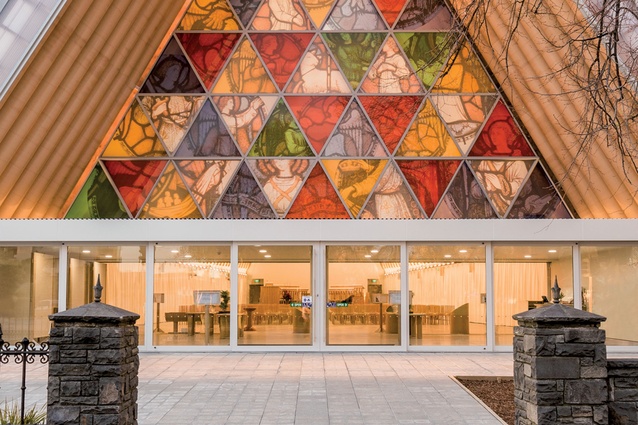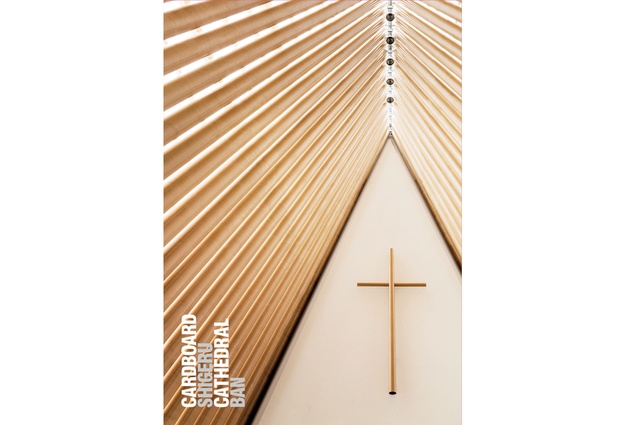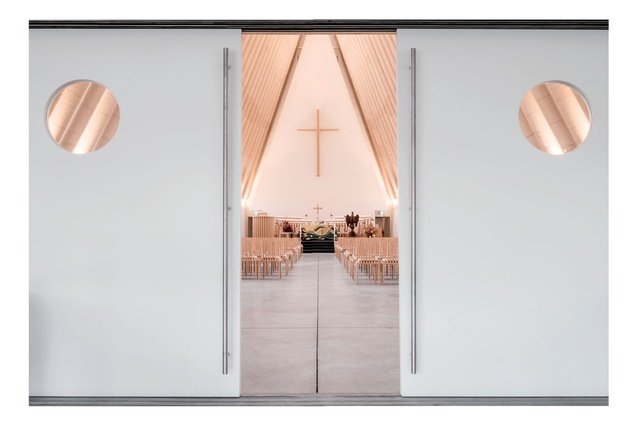Shigeru Ban: Cardboard Cathedral
Foreward by the very reverend Lynda Patterson, Dean of Christchurch Cathedral, commentary by Shigeru Ban, essay by Andrew Barriee and afterword by David Mitchell; Photography by Bridget Anderson and Stephen Goodenough; Auckland University Press; ISBN: 9781869407674; $59.99
Armed with a cardboard key, Anglican Bishop Victoria Matthews took charge of Christchurch Transitional Cathedral in early August 2013, shortly after the untimely death of the Very Reverend Lynda Patterson, Dean of Christchurch Cathedral. Matthews must have felt that a bloody battle had been won even though the High Court had ruled that, under her chairmanship, the church property trustees had used insurance monies illegally for the build. Published a year after that moment, this 250-page book is both document and souvenir, making the story of the project legible and memorable through a compelling combination of text and image.
Alt Group’s exemplary design maintains the glamour of The Pritzker Architecture Prize laureate Shigeru Ban’s architecture, while deploying an eco-friendly, brown-bread look with the various types of recycled paper stock used in the printing. These are a nod to Ban’s signature brand aesthetics: the item in his repertoire of materials which The New Yorker writer Dana Goodyear calls “his main dance move”, the cardboard tube. Concept drawings, plans and elevations are reproduced simply enough for the lay reader to find them comprehensible. Bunched at the back of the book and printed on the same grey paper that carries the main essay by Andrew Barrie, they are the companion to his explanation of the building technology.
As illustrations, however, they are completely upstaged by the series of magnificent colour plates by Stephen Goodenough that precede them. Commencing with a double-page spread of the empty church lit up at dusk, this sequence culminates with the same view filled with people in daytime, immediately preceded by an interior image of the crucession on the day of dedication. Complemented by a brilliant black-and-white captioned photo essay by University of Canterbury visiting photography lecturer Bridgit Anderson, the 150 pages of photographs in this book are the scene-stealers.
Yet the wholesome physical properties of the book, and its heft and shape, encourage full digestion rather than the coffee-table browse, and the reading is rewarding. Ban – who provided his design services for free – also submitted an essay for the publication, which includes this most quotable quote: “Architects mostly work for privileged people, people who have money and power. Power and money are invisible, so people have us to visualise their power and money by making monumental architecture.” The NZIA award-winning Auckland architect, who is well-versed in making a client’s net worth evident, David Mitchell (also creative director of Last, Loneliest, Loveliest, the New Zealand Pavilion at this year’s 14th International Architecture Exhibition Venice Biennale) concludes in the Afterword to this book that earthquake damage to Christchurch Cathedral “may signal an end to Englishness in New Zealand’s most English city” and commends Ban’s work as ur-Japanese.
Not so fast, Kemosabe. Shigeru Ban is known as “The American” in Japan and, as any born-and-bred Cantabrian will proudly tell you, Christchurch was a Church of England settlement. The first ships carrying British settlers arrived in December 1850, building huts along the Avon River in the area now designated as North Hagley Park. Almost every Canterbury architect recites a whakapapa back to these little wooden gems, made legendary by Dr Barker’s photographs. They offer a point of origin for every narrative of local architectural development that favours excursions into hybridity. Barker’s photographs show European niceties, such as weatherboard fronts, hinged doors and framed glass windows, tucked under the acute angles of V-shaped roofs that each drop down to the ground in a dramatic diagonal from a central ridge. Thatched with native flax, they can sustain comparison to the Ma-ori whare and this makes it seem deceptively simple to build across cultures.
Flash forward 165 years to contemplate the giant equilateral geometric formation of the front façade of Shigeru Ban’s Cardboard Cathedral, and the excerpts from the circular rose window in its Trinity Window. Is there not a hint of Ma-ori tukutuku patterning in the irregularly dispersed red, yellow, green and blue triangles which comprise it?
In summary, the publication of this book records an important moment in our architectural history. Is the building of Shigeru Ban’s Cardboard Cathedral an equally significant moment in the history of the Anglican church? Andrew Barrie’s text notes that, reflecting local priorities, the Canterbury Crusaders managed to beat these Christians to the goalpost of erecting the first new public building after the earthquake. The capacity of Christchurch Stadium is 25 times that of the church, and it cost 100 times as much to build, indicating that rugby really is the new religion in 21st century New Zealand.












